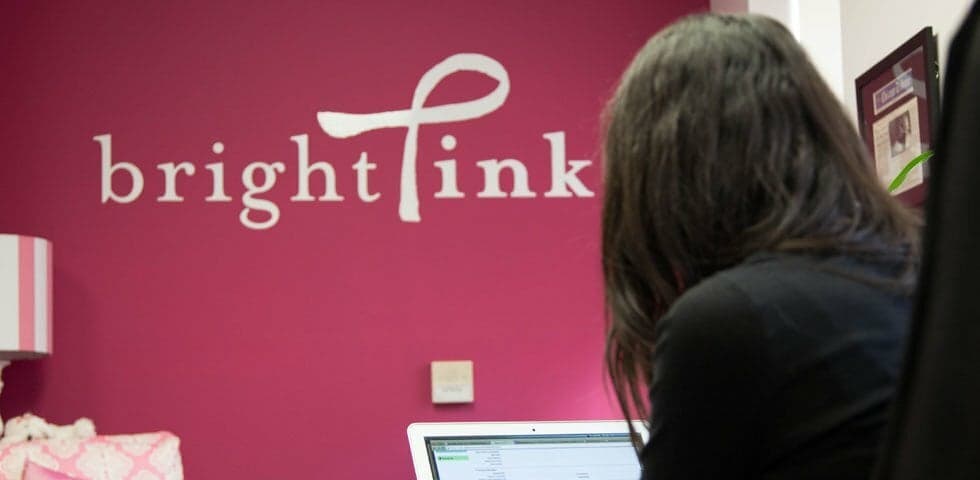Ever had a conversation with someone who just blows you away? I had that experience chatting with Lindsay Avner, Founder and Executive Director of Bright Pink. Avner is a vibrant woman with a remarkably inspiring story. She has an extremely strong family history of both breast and ovarian cancer. At the age of 23, Avner made the controversial decision to undergo a preventative mastectomy, making her the youngest woman in the country to have the procedure.
Going through this, Avner became acutely aware of the limited resources available to inform young women about their risk of developing breast and ovarian cancer, and what they can do to prevent the diseases. Since then, Avner and the team at Bright Pink have focused on the education, early detection, and prevention of breast and ovarian cancer for young women.
What inspired you to start Bright Pink?
Both my grandmother and great grandmother died a week apart from breast cancer before I was born, at ages 39 and 58. There were 11 other women from both my mom’s maternal and paternal sides of the family, including my mother, with signs of these diseases. To say I have a family history is quite an understatement.
I was very involved with Susan G. Komen for the Cure and Research for the Cure growing up, but I never thought I would have to deal with what it meant for my own health at such a young age. When I was 22, genetic testing revealed that I tested positive for the BRCA1 gene mutation.
What this meant is that, if the average woman has a one in eight lifetime risk of developing breast cancer (about a 12% risk), I had up to an 87% risk of developing the disease. If the average woman has a 1% chance of developing ovarian cancer, I had a 54% risk myself.
Originally, I enrolled in several high-risk screening programs including MRIs, mammograms, and clinical breast exams. In the end, I came to the decision that I didn’t just want to look for cancer. I decided to have a preventative mastectomy when I was 23.
At that time, there weren’t any resources focused on my situation: a young woman who didn’t actually have cancer, but had a very high risk for developing the disease. Going through that experience really prompted me to ask myself, “What can I do to fill this niche in the cancer community?”
So what is your goal with Bright Pink?
Our focus is two-fold: education and support. Our goal is to help young women understand their own risk for developing breast and ovarian cancer, to inform them of strategies they can put in place in their 20s and 30s to be proactive with their breast and ovarian health.
We also support those who are high-risk and are going through difficult things like genetic testing, surgery, or losing a parent to cancer. When I started Bright Pink in 2007, it became clear very quickly that there were other women out there with situations similar to mine, who had always wanted to do something to be proactive about their breast and ovarian health. We’re there for them.
Could you describe a few indicators of being at high risk for breast and ovarian cancer?
The list is extensive, but family history is very powerful. There are certain indicators that are a good sign it would make sense for you to talk to a genetic counselor:
What are the most common misconceptions about breast and ovarian cancer?
This could be an article in itself. But a few key ones:
Many women have some awareness of their breast and ovarian health, but don’t think about its real impact on their own lives. What advice do you have for those women?
It’s a whole lot easier to make decisions about your health when you’re not in crisis mode. If you think of your seven closest friends, statistically, it’s likely that one of you will develop breast cancer in your lifetime. That’s a pretty high statistic. And the moment someone is diagnosed, the plethora of life changing questions and decisions she’s forced to make is tremendous.
What’s beautiful about the work that we do is that the women we support have a chance to ask the hard questions and find out difficult information, and they have time to process it. They can then educate themselves, make sure the women in their lives are educated, and find ways to be proactive about their health.
Most young women are very busy and have a difficult time keeping track of everything, let alone a disease for which they haven’t been diagnosed as high risk. What can women do now to be proactive regarding their breast and ovarian health?
There are so many things young women can do to take control of their breast and ovarian health.
How can young women get involved in what Bright Pink is doing?
Our website is our main hub for all of our resources. We create programs based on real needs. One program we’re particularly proud of is called “Pink Pals,” which is a one-on-one peer support initiative that pairs young women going through tough breast and ovarian cancer issues with mentors of similar demographics who have already gone through it before.
We have 13 chapters across the country, so young women near any of our chapters can get involved there. We need volunteers to help spearhead fun events, get the word out about the organization at community events, and create training modules for young women and medical professionals.
To learn more about Bright Pink, educate yourself about breast and ovarian health, and get involved, visit www.BeBrightPink.org.


